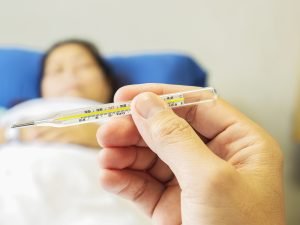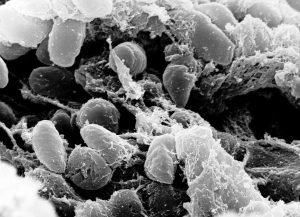Summary
The bubonic plague, also known as the “Black Death,” is a type of infectious disease that causes infection in the lymph nodes, also known as “kulani” in Filipino. Unlike ordinary infections, the bubonic plague is life-threatening due to its potential for severe complications. This disease is caused by the bacterium Yersinia pestis, which can enter the human body through the bite of fleas carried by small, furry animals such as rats, rabbits, dogs, and cats.
Symptoms of the bubonic plague typically appear within 1 to 7 days after initial exposure and infection. The primary sign of this condition is swollen lymph nodes (known as “buboes”), commonly located in the neck, armpits, or groin. These buboes can swell to the size of a chicken egg. As the condition worsens, parts of the body like the fingers, toes, lips, and nose can turn black and necrotic due to tissue death, which is why it is also called the “Black Plague.”
Although the bubonic plague is highly lethal, survival is possible if treatment is administered quickly. Patients need to be hospitalized immediately to receive effective antibiotics, which are critical in combating the infection. Additionally, supportive treatments, such as IV fluids, oxygen, or advanced respiratory support, may be necessary to stabilize the patient and enhance recovery.
Table of Contents
- Symptoms of Bubonic Plague (Black Death)
- Diagnostic Procedures for Bubonic Plague (Black Death)
- Complications of Untreated Bubonic Plague (Black Death)
- Causes of Bubonic Plague (Black Death)
- Prevention of Bubonic Plague (Black Death)
- Risk Factors for Bubonic Plague (Black Death)
- Bubonic Plague (Black Death) FAQs
Symptoms of Bubonic Plague (Black Death)
 Image Source: www.freepik.com
Image Source: www.freepik.com
A person may be diagnosed with the bubonic plague if they display or experience the following symptoms:
- Fever. Often high and accompanied by chills, fever is one of the earliest signs of infection.
- Muscle chills and tremors. Muscle shakes and chills are common as the body attempts to combat the infection.
- Muscle pain and cramps. Muscle aches and cramps, often severe, may indicate the body’s reaction to the infection.
- Headache. Intense headaches are a frequent symptom due to the body’s inflammatory response.
- Vomiting. Nausea and vomiting may occur as the infection affects the gastrointestinal system.
- General body weakness. Fatigue and weakness set in as the infection spreads, draining the body’s energy.
- Swollen and painful lymph nodes in the neck, armpit, or groin. These swollen nodes (buboes) are tender and a defining symptom.
- Enlarged lymph nodes. The nodes can swell up to the size of a chicken egg, becoming noticeably enlarged.
- Blackening and necrosis of fingers, toes, lips, and nose. As the infection progresses, tissue death (necrosis) can turn extremities black.
Symptoms of the bubonic plague may take up to 7 days to appear after exposure to the bacterium. However, in many cases, symptoms begin as early as 24 hours post-infection. Initially, the symptoms may resemble those of a common flu, leading to potential misdiagnosis. However, unlike flu symptoms, those of the bubonic plague rapidly intensify, with painful buboes and tissue darkening emerging as key signs that distinguish it from less severe illnesses.
Diagnostic Procedures for Bubonic Plague (Black Death)
Diagnosing bubonic plague requires a combination of clinical evaluation, patient history, and laboratory testing to confirm the presence of Yersinia pestis. Early detection is crucial, as the disease progresses quickly and can be life-threatening if not treated promptly.
- Physical examination and symptom analysis. A healthcare provider first assesses symptoms and performs a physical exam. Swollen, painful lymph nodes (buboes) in the neck, armpits, or groin, along with fever, chills, and headache, are significant indicators of bubonic plague.
- Medical and exposure history. Doctors inquire about recent travel to areas with known plague cases, outdoor activities like camping or hunting, and exposure to animals that may carry infected fleas to gauge the likelihood of exposure to Yersinia pestis.
- Blood tests. Blood samples are analyzed for Yersinia pestis bacteria or specific antibodies that indicate infection. While bacteria may not always appear in blood in the early stages, blood tests can show signs of infection or sepsis.
- Lymph node aspiration. A needle is used to extract fluid from a swollen lymph node (bubo) for testing. This procedure provides a reliable method for detecting Yersinia pestis, which is often concentrated in the lymph nodes.
- Sputum or phlegm tests. If pneumonic symptoms are present, sputum or phlegm samples are tested to check if the infection has spread to the lungs, making it more contagious and requiring isolation measures.
- Polymerase chain reaction (PCR) testing. PCR testing identifies Yersinia pestis DNA in a sample. This sensitive and rapid test provides faster results than traditional culture methods, allowing for timely confirmation.
- Immunohistochemistry or serological tests. For late-stage or post-infection diagnosis, these tests detect plague-specific antibodies, which can confirm infection if other tests are inconclusive.
Early and accurate diagnosis of bubonic plague is essential to prevent complications and control potential outbreaks. Combining symptom analysis with targeted laboratory tests, especially lymph node aspiration and PCR, enables rapid treatment, reducing the risk of severe outcomes.
Complications of Untreated Bubonic Plague (Black Death)
If left untreated, the bubonic plague can lead to severe complications that increase the risk of death and further spread of infection. Without timely medical intervention, the disease can progress rapidly and affect multiple systems in the body, causing life-threatening conditions.
- Septicemia. Untreated bubonic plague can cause septicemia, a severe blood infection that occurs when Yersinia pestis spreads through the bloodstream. This condition leads to systemic inflammation, blood clotting abnormalities, and tissue damage, often resulting in organ failure.
- Pneumonic plague. The infection may spread to the lungs, resulting in pneumonic plague, which is more contagious and potentially fatal. This form of the disease can spread through respiratory droplets, making it a serious public health threat that requires isolation and immediate treatment.
- Meningitis. In rare cases, Yersinia pestis can infect the brain and spinal cord membranes, causing meningitis. This condition leads to symptoms like high fever, severe headache, neck stiffness, and sensitivity to light and can cause brain damage or death if untreated.
- Gangrene. Advanced infection can cause gangrene, or tissue death, especially in the fingers, toes, and extremities. Reduced blood flow and severe bacterial infection lead to blackened, necrotic tissue that may require surgical removal or amputation.
- Acute respiratory distress syndrome (ARDS). If the lungs are severely affected by pneumonic plague, patients may develop ARDS, a critical condition characterized by fluid accumulation in the lungs. ARDS impairs oxygen exchange, requiring intensive respiratory support and increasing the risk of fatality.
The complications of untreated bubonic plague can escalate quickly, leading to widespread infection and irreversible damage to vital organs. Early diagnosis and prompt antibiotic treatment are essential to avoid these severe outcomes, limit the disease’s spread, and ensure a higher likelihood of recovery.
Causes of Bubonic Plague (Black Death)
 Image Source: en.wikipedia.org
Image Source: en.wikipedia.org
The cause of the bubonic plague is the bacterium Yersinia pestis. This bacterium lives within fleas, which in turn live on small, furry animals such as rats and rabbits. Humans can contract the bubonic plague through several pathways:
- Bite from an infected flea. Fleas carrying Yersinia pestis can transmit the bacterium directly to humans through a bite.
- Consumption of infected animal meat. Eating the undercooked or contaminated meat of infected animals can transmit the disease.
- Contact with the body or fluids of an infected, deceased animal or person. Handling the carcass or bodily fluids of an infected animal or human can expose individuals to the bacterium.
- Touching contaminated items of an infected person. Contact with objects contaminated by pus, blood, or other fluids from an infected person can spread the bacteria.
While bubonic plague is not spread through inhaling droplets or small saliva particles from an infected person, it can worsen into pneumonic plague, which affects the lungs. In this form, the disease can be transmitted through inhaling respiratory droplets. During historical outbreaks, the rapid spread of bubonic plague was exacerbated when cases progressed to pneumonic plague, allowing airborne transmission and leading to swift outbreaks across populations.
Prevention of Bubonic Plague (Black Death)
To prevent contracting bubonic plague, follow these safety precautions:
- Avoid contact with patients who have bubonic plague. If interaction is necessary, wear a face mask, as the patient’s condition could have progressed to pneumonic plague, which can be spread through respiratory droplets.
- Avoid touching the personal belongings of a patient with bubonic plague. If it’s necessary to handle these items, wear gloves to prevent contact with potentially infectious material.
- Wash hands regularly, especially before eating. This helps eliminate any bacteria that may have come into contact with your hands.
- Maintain good personal hygiene through daily bathing. Regular bathing reduces the risk of carrying bacteria on the skin.
- Keep pets such as rats, rabbits, dogs, and cats clean and flea-free. Ensure they are checked regularly to prevent flea infestations that could harbor Yersinia pestis.
- Avoid handling wild animals. Wild animals, especially in forested areas, can carry fleas that may transmit plague bacteria.
- Do not eat wild-caught animals, especially if there are active cases of bubonic plague in your area. Eating such meat could lead to infection if the animal was a carrier.
- When traveling internationally, choose destinations free from bubonic plague outbreaks. Check health advisories before traveling to prevent exposure.
- Keep your environment clean to discourage rodent infestations. This reduces the risk of plague-carrying fleas entering the home.
- Use insect repellents or pesticides to kill fleas in the home and surrounding areas. This can help eliminate potential flea carriers of the disease.
- Avoid handling dead animals, as they may harbor bacteria that cause bubonic plague. This includes roadkill and any dead animals found in areas known for plague cases.
Implementing these measures helps reduce exposure to Yersinia pestis bacteria, significantly lowering the risk of contracting the bubonic plague.
Risk Factors for Bubonic Plague (Black Death)

Image Source: www.stockvault.net
According to doctors, the likelihood of contracting bubonic plague is very low. However, certain risk factors increase the chances of acquiring this condition:
- Living in unsanitary areas with high rodent populations. Environments with poor sanitation and many rats create conditions where plague-carrying fleas are more likely to thrive.
- Residing in or traveling to areas with high plague incidence, such as parts of Africa, Asia, and South America. These regions have experienced plague cases, making them higher-risk for potential exposure.
- Working in high-risk professions, such as veterinarians, nurses, doctors, and other healthcare workers. These professions may require handling animals or human patients that could be infected with Yersinia pestis.
- Engaging in outdoor activities like hunting, camping, and hiking. These activities increase exposure to wild animals and fleas that may carry the plague bacterium.
- Consuming wild game meat. Eating wild-caught animals, especially from regions with active plague cases, can expose individuals to the bacteria if the animal was infected.
While the risk of contracting bubonic plague remains minimal, awareness of these risk factors and taking preventative measures can help further reduce the chances of infection.
Bubonic Plague (Black Death) FAQs
The bubonic plague, often referred to as the Black Death, is a highly infectious disease caused by the Yersinia pestis bacterium. Historically, it led to one of the deadliest pandemics in human history during the 14th century. Though rare today, cases still occur, primarily in areas with high rodent populations and inadequate sanitation. Here are answers to some of the most frequently asked questions about the bubonic plague, including symptoms, transmission, and prevention.
- What is the bubonic plague?
The bubonic plague is an infectious disease caused by Yersinia pestis bacteria, which primarily affects the lymphatic system. It is transmitted to humans through flea bites, especially fleas that have fed on infected animals. - What are the symptoms of the bubonic plague?
Symptoms usually appear 1-7 days after exposure and include fever, chills, muscle pain, headaches, vomiting, swollen and painful lymph nodes (buboes), and, in severe cases, blackening of extremities like fingers and toes due to necrosis. - How is the bubonic plague transmitted?
The primary mode of transmission is through the bite of an infected flea. Other methods include handling infected animal tissue, consuming infected meat, or exposure to bodily fluids from an infected individual or animal. - Can the bubonic plague spread from person to person?
Direct person-to-person transmission is rare for the bubonic form. However, if the disease progresses to pneumonic plague, which affects the lungs, it can be spread through respiratory droplets. - How is the bubonic plague treated?
With early medical intervention, antibiotics such as streptomycin, doxycycline, or ciprofloxacin are highly effective in treating the infection. Supportive care, including hydration and respiratory support, may also be necessary. - Who is most at risk for contracting the bubonic plague?
Those living in unsanitary conditions with high rodent populations, individuals in areas with active plague cases (e.g., parts of Africa, Asia, and South America), and people who frequently handle animals or wildlife, such as veterinarians and hunters, are at higher risk. - How can I protect myself from the bubonic plague?
Preventive measures include avoiding contact with wild animals, using insect repellent to prevent flea bites, maintaining good hygiene, and steering clear of regions experiencing active plague cases. - Is the bubonic plague still a concern today?
Although rare, the bubonic plague has not been eradicated. Small outbreaks are reported annually in certain regions, but modern medicine and quick access to antibiotics have made it manageable and preventable in most cases.


